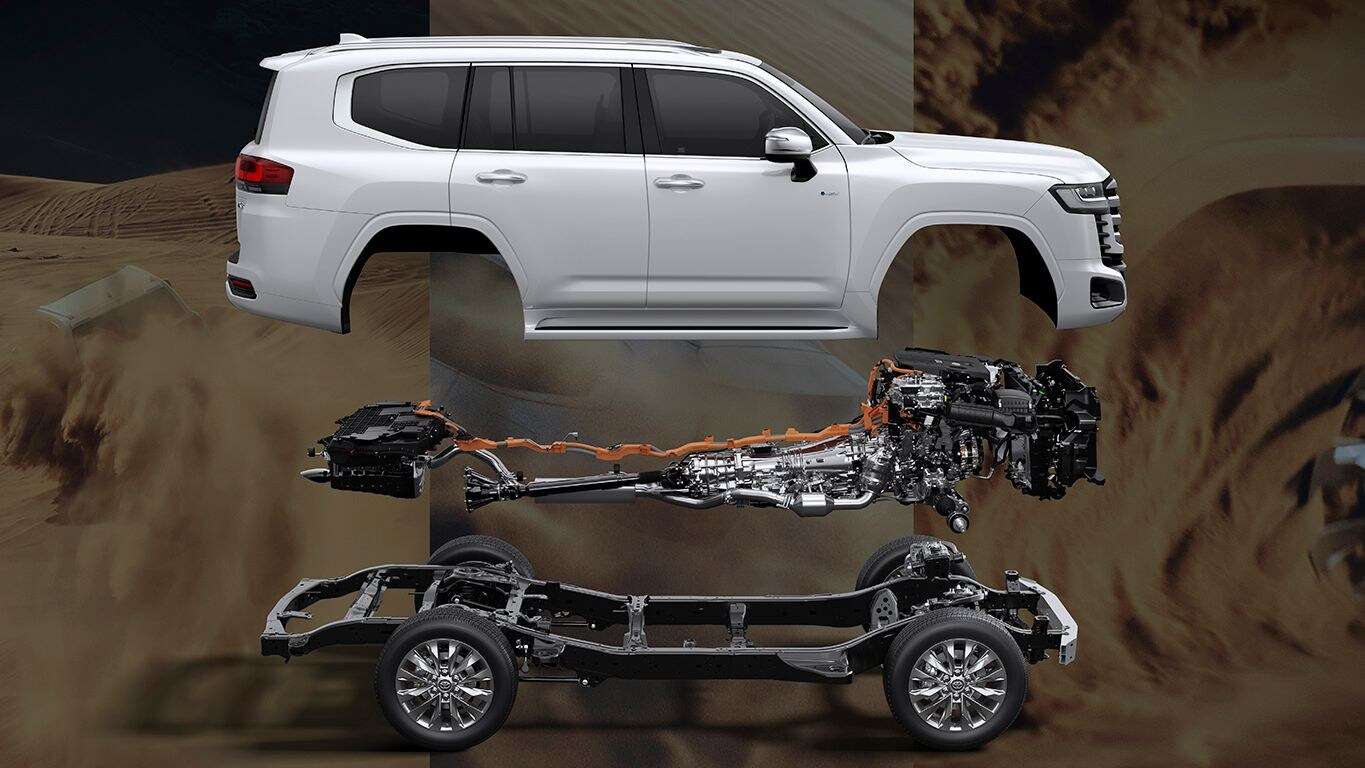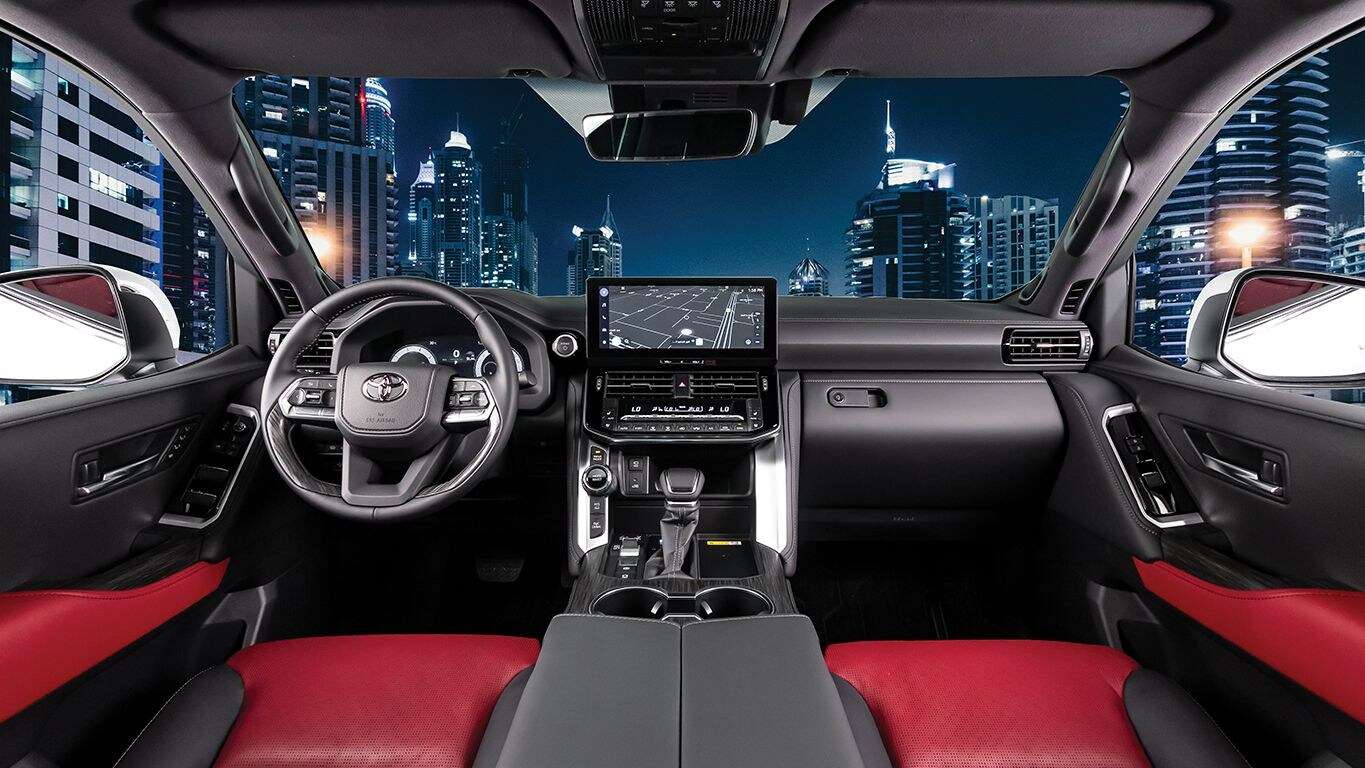Power, Efficiency, and the Future of Off-Roading
Toyota has recently introduced an exciting new variant to its legendary Land Cruiser lineup: the Toyota Land Cruiser LC300 Hybrid. While initially launched for the Middle Eastern market, there’s a strong possibility that this formidable SUV will make its way to other regions, including Indonesia. Toyota Australia, for instance, has confirmed its intention to introduce the Land Cruiser Hybrid in the first half of 2026. This new hybrid iteration marks a significant step forward for the Land Cruiser, combining its renowned rugged capabilities with enhanced power and, presumably, improved fuel efficiency.

The Land Cruiser Hybrid is equipped with a powertrain similar to that found in the Lexus LX: a 3.5-liter twin-turbo V6 gasoline engine. This robust internal combustion engine is complemented by a single electric motor, forming a parallel hybrid system. This integrated setup allows for a powerful combination of gasoline and electric propulsion, designed to deliver both exhilarating performance and a more environmentally conscious footprint.

Figure 1: Cutaway view of the Toyota Land Cruiser LC300 Hybrid, showcasing its advanced powertrain.
Performance and Efficiency
The combined output of the V6 engine and the electric motor is an impressive 450.5 horsepower (hp) and a substantial 750 Newton-meters (Nm) of torque. This represents a significant leap in power compared to the V6 turbodiesel engine found in the LC300 currently available in Indonesia, which produces 300.7 hp. The hybrid system is mated to a smooth and efficient 10-speed automatic transmission. With these formidable figures, Toyota confidently asserts that this is the most powerful Land Cruiser they have ever produced.

While official fuel consumption figures have not yet been disclosed by Toyota, overseas media outlets comparing it to the Lexus LX suggest a potential five to ten percent improvement in fuel economy. However, it’s important to note that these are currently just estimations. Toyota also claims to have rigorously tested the LC300 Hybrid across various extreme terrains, ensuring its legendary off-road prowess remains uncompromised despite the addition of hybrid technology.
Design and Practicality
Visually, the exterior of the Land Cruiser Hybrid exhibits only minor differences from its non-hybrid counterparts. The most noticeable distinction is the addition of an “HEV” (Hybrid Electric Vehicle) emblem on the tailgate. Furthermore, a practical 1,500-watt power outlet is located at the rear, a thoughtful inclusion for powering equipment during camping or other outdoor activities, highlighting its versatility beyond just transportation.

Figure 2: Interior view of the Toyota Land Cruiser LC300 Hybrid, showing its refined cabin.
Pricing Overview
In terms of pricing, the Toyota Land Cruiser Hybrid in the United Arab Emirates is listed at approximately $105,273 USD (based on an exchange rate of 1 AED = 0.27 USD). The GR-S variant of the hybrid is priced at approximately $110,673 USD. For comparison, the Toyota Land Cruiser VX-R in Indonesia is priced at around $161,494 USD, while the sportier Land Cruiser GR-S costs about $166,000 USD. These price comparisons highlight the potential market positioning of the hybrid variant should it arrive, offering a potentially more accessible entry point for the latest generation Land Cruiser.
The Evolution of an Icon: Comparing the LC300 Hybrid to its Predecessors
The introduction of the LC300 Hybrid is not just an incremental update; it represents a significant evolution in the Land Cruiser’s long and storied history. To truly appreciate its advancements, it’s crucial to understand how it differs from previous generations and, more specifically, the conventional internal combustion engine (ICE) variants of the LC300.
Historically, Land Cruisers have been celebrated for their unwavering reliability, robust build quality, and unparalleled off-road capabilities, primarily powered by durable gasoline or diesel engines. The LC300 series, which debuted as the successor to the LC200, already brought significant improvements in terms of platform, technology, and engine options.
Platform and Design
The LC300 series, including the new hybrid, utilizes the TNGA-F platform. This body-on-frame architecture, while retaining the Land Cruiser’s rugged DNA, incorporates lighter materials and advanced manufacturing techniques. This results in improved rigidity, reduced weight, and enhanced driving dynamics compared to the older LC200 platform. The lighter platform, coupled with the hybrid powertrain, further optimizes the vehicle’s performance and efficiency. While the external styling of the LC300 Hybrid largely mirrors its non-hybrid siblings, subtle cues like the “HEV” emblem signify its electrified nature, hinting at its advanced underpinnings.

Powertrain Philosophy
The most striking difference, of course, lies in the powertrain. Previous Land Cruiser generations heavily relied on large displacement V8 gasoline or V8/V6 diesel engines. These engines, while powerful and dependable, were primarily focused on raw power and durability, often at the expense of fuel efficiency and emissions.

The LC300 Hybrid, on the other hand, embraces a parallel hybrid system. This means the electric motor can assist the gasoline engine, drive the vehicle independently at low speeds, or provide an extra boost of power when needed. This approach offers several advantages:
- Instant Torque: Electric motors deliver maximum torque from a standstill, providing immediate acceleration and enhanced responsiveness, particularly useful for off-road maneuvers or quick overtakes.
- Improved Fuel Efficiency: By allowing the electric motor to take over in certain driving conditions (e.g., city driving, coasting), the hybrid system significantly reduces fuel consumption and, consequently, CO2 emissions.
- Enhanced Power Delivery: The combined output of the V6 twin-turbo gasoline engine and the electric motor results in a higher peak power and torque output than even the most powerful diesel variants of the LC300, making it the most potent Land Cruiser to date.
- Reduced Noise and Vibration: At lower speeds or when operating in electric-only mode, the hybrid Land Cruiser offers a quieter and smoother driving experience compared to its purely ICE counterparts.
Technological Advancements
Beyond the powertrain, the LC300 Hybrid integrates the latest in Toyota’s automotive technology. While the standard LC300 is already packed with advanced driver-assistance systems (ADAS), infotainment, and connectivity features, the hybrid variant benefits from the synergy of an electrified drivetrain. This might include more sophisticated energy management systems, regenerative braking, and potentially even vehicle-to-load (V2L) capabilities, as hinted by the 1,500-watt power outlet, allowing the vehicle to power external devices. Such features enhance the Land Cruiser’s utility, making it not just a powerful off-roader but also a versatile mobile power source.
Environmental Impact
In an increasingly environmentally conscious world, the hybrid Land Cruiser addresses concerns regarding emissions and fuel consumption. While a large SUV will never be a zero-emission vehicle, the hybrid system significantly reduces its carbon footprint compared to traditional gasoline or diesel engines, aligning with global efforts towards greener transportation. This makes the Land Cruiser LC300 Hybrid a more sustainable choice for those who demand both luxury and off-road capability.
Advantages and Disadvantages: A Comparative Analysis
To further illustrate the advancements and trade-offs, let’s examine the pros and cons of the Toyota Land Cruiser LC300 Hybrid compared to its predecessors, particularly the non-hybrid LC300 models.
| Feature / Aspect | Toyota Land Cruiser LC300 Hybrid (Pros) | Toyota Land Cruiser LC300 Hybrid (Cons) |
|---|---|---|
| Performance |
|
|
| Fuel Efficiency & Emissions |
|
|
| Technology & Features |
|
|
| Off-Road Capability |
|
|
Comparison with Older Generations (LC200 and earlier)
When compared to the LC200 and older Land Cruiser generations, the LC300 Hybrid represents a paradigm shift. Earlier models, while incredibly durable, often featured heavier platforms, less efficient V8 engines, and lacked the sophisticated electronic driver aids and luxury features of the modern LC300. The LC300’s TNGA-F platform alone delivers a significant improvement in weight, rigidity, and overall driving dynamics. The shift from hydraulic power steering to electric power steering also offers a more refined driving feel and allows for advanced driver-assistance features like lane-keeping assist.
The most notable upgrade is the move away from naturally aspirated V8 engines (like the 5.7L gasoline or 4.5L diesel V8s in the LC200) to more advanced, smaller displacement twin-turbo V6 engines, now augmented with hybrid technology. This change allows for superior power output with better efficiency, aligning the Land Cruiser with modern automotive trends. Interior comfort, infotainment, and safety features have also seen massive leaps, offering a more premium and secure experience.
Potential Challenges and Future Outlook
While the Land Cruiser LC300 Hybrid brings numerous advantages, it also faces potential challenges. The primary one will be market acceptance, particularly in regions deeply loyal to traditional ICE Land Cruisers. Educating consumers about the benefits of hybrid technology in a rugged off-roader will be key. Furthermore, the long-term durability and repairability of hybrid components in extremely harsh off-road environments will be a point of scrutiny for enthusiasts, despite Toyota’s assurances and extensive testing.
The future of the Land Cruiser, as exemplified by the LC300 Hybrid, points towards a continued blend of traditional ruggedness with advanced, efficient powertrains. As global regulations tighten and consumer preferences shift towards more sustainable options, hybrid and potentially even full-electric powertrains will likely become standard for such large SUVs. Toyota’s strategic move with the LC300 Hybrid positions the Land Cruiser to remain relevant and competitive in an evolving automotive landscape, ensuring its legacy as the “King of Off-Road” endures for generations to come.

